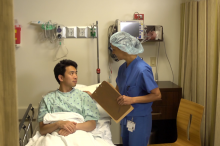Located in Beverly Hills, La Peer Health Systems’ Orbital Surgery Center of Excellence boasts some of the most distinguished surgeons and latest technology in Los Angeles. Working in conjunction with your head and neck thyroid surgeon and endocrinologist, our occuloplastic surgeons specialize in orbital decompression, a treatment for Thyroid Eye Disease.
Graves Disease or Thyroid Eye Disease
Thyroid Eye Disease also known as Graves’ Disease is an autoimmune disease in which the thyroid produces an excessive amount of hormones, causing hyperthyroidism, which can cause swollen eye muscles and tissues.
As a result of swollen eye muscles pushing against bone, the eyes appear to bulge out of their sockets—the main symptom of this condition. Advanced cases of thyroid eye disease usually call for surgical treatment such as orbital decompression as well as thyroid surgery.
Causes of Thyroid Eye Disease
Thyroid Eye Disease usually affects women more than men. The main causes of Graves disease are still unclear although researchers have concluded that it is a combination of both genetic and environmental factors, such as stress. Studies have also found that smoking worsens thyroid eye disease.
Symptoms of Thyroid Eye Disease
Symptoms of Graves disease can be common in other conditions as well and are always best diagnosed by an eye surgeon, head & neck surgeon and/or an endocrinologist.
In some cases of Graves Disease, the eyes can go completely unaffected. In other cases, many symptoms can revolve around swelling of the eye tissue. Swollen eye muscles can put tremendous pressure on the optic nerve, possibly leading to partial blindness. Eye muscles are weakened by long periods of inflammation and lose their ability to control movement, resulting in double vision. Other symptoms can include:
- Pain in the eyes, pain when looking up, down or sideways
- Dryness, itching, dry eyes, difficulty wearing contact lenses
- Inflammation and swelling of the eye, and its surrounding tissues
- Swelling in the orbital tissues
- Bloodshot appearance to eyes
- Double vision
- Impaired vision
Orbital Decompression for Thyroid Eye Disease
Orbital decompression is a surgical treatment option performed by an oculoplastic surgeon at our Beverly Hills surgical center. It involves removing bone around the eye socket to make more space for the swollen tissue and allow the eyes to move back into their original position. Our surgeons at the Orbital Surgery Center of Excellence use the latest and most minimally invasive techniques to achieve the desired effect. This is an outpatient surgery with about 7-10 days of postoperative swelling/bruising.
During orbital decompression, patients are placed under general anesthesia. Once anesthesia has been administered to the patient, our expert surgeons begin performing the procedure. When performing orbital decompression surgery, surgeons utilize a special tool inserted through the nose. This tool, called an endoscope, is fitted with a tiny camera that allows surgeons to visually scan and identify the operation area. Surgeons then remove bones from the medial and inferior orbit, reducing pressure on the eyes and allowing the eyes to return to their natural position within the skull.
Other Treatments for Thyroid Eye Disease
Most mild cases of Graves Disease are treated with anti-inflammatory or lubricating eye drops, however some cases can involve an oculoplastic surgeon to treat any symptoms affecting the eyes.eyelid-retraction-for-thyroid-eye-disease-los-angeles
Eyelid muscles can become tight, making it impossible to completely close the eyes. This can be treated with lubricant gel at night, or with tape on the eyes to enable full sleep. In some cases of severe symptoms threatening vision more serious steps are taken. Steroids or surgical options, such as orbital decompression, are explored to relieve any type of pressure on the optic nerve or if the cornea is exposed. Smoking tobacco cessation is necessary in all cases.
Aside from the eyes, the treatment of Graves Disease also focuses on treating the thyroid gland itself, sometimes through medication and sometimes through minimally invasive surgery. Many times, in addition to an oculoplastic surgeon, a patient with Grave’s Disease will have a team of doctors including an endocrinologist and a head and neck surgeon.
Orbital Decompression and Thyroid Eye Disease FAQs
What causes Graves’ Disease?
Grave’s Disease is a result of an overactive thyroid. Although doctors are unsure what gene is directly related to the condition, it is believed that Grave’s Disease is a combination of both environmental and genetic factors combined.
Why is ocular decompression necessary?
In severe cases of thyroid eye disease, pressure from swollen eye tissue can press against the optic nerve causing partial blindness. To avoid this, one of our surgeons at the Orbital Surgery Center of Excellence will make small incisions around your eye and remove a small amount of bone to relieve the pressure.
Contact a Surgeon at the Orbital Surgery Center of Excellence
If you are experiencing the symptoms of Thyroid Eye Disease or Graves’ Disease and would like to know more about orbital decompression, please contact our highly-trained doctors at the Orbital Surgery Center of Excellence in Beverly Hills at (888) 559-4341.
Let us verify your insurance with our Free Insurance Verification form!
Next, learn more about Orbital Tumors and Infection.














